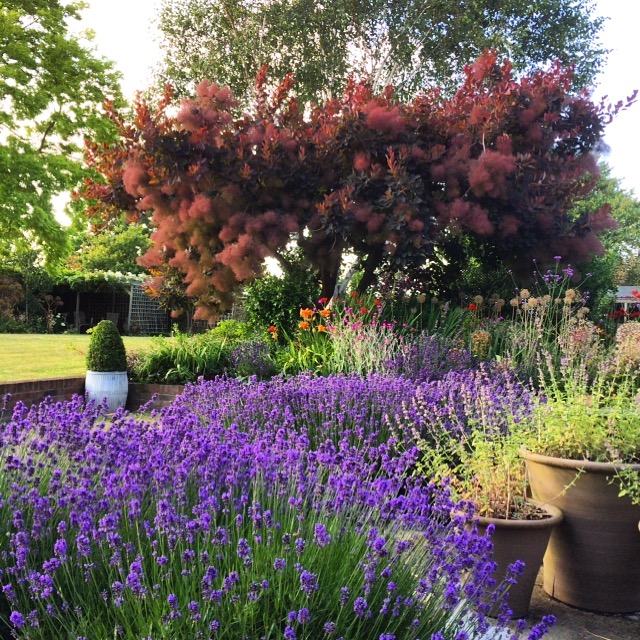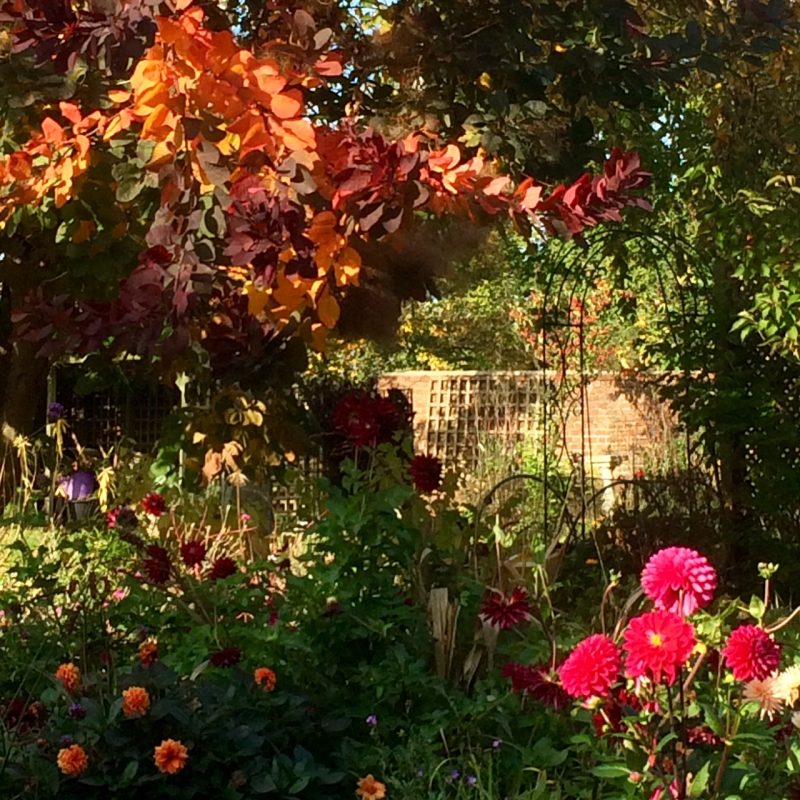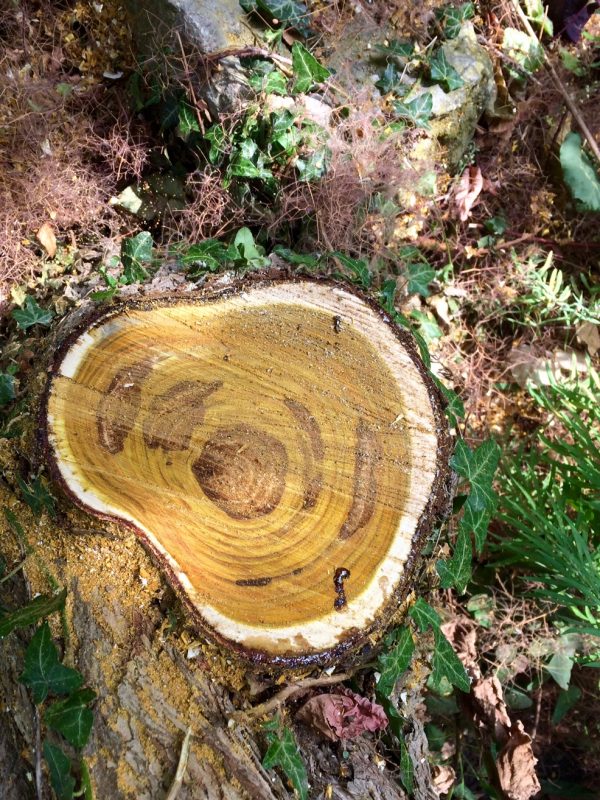Sudden tree death is a particular tragedy for small and middle-sized gardens. We only have a few trees and each one is special.
We have a Cotinus coggygria ‘Grace’ which has grown to a height and spread of around 7 metres (about 25ft).

Cotinus coggygria ‘Grace’ in summer 2015. It’s the deep red tree.
Its glorious red foliage is the main focus in the garden, especially in autumn when it changes from glowing copper to burnished gold almost in front of our eyes.

The copper and gold of the autumn cotinus have inspired the rich red theme for our dahlias.
This year has seen a long, cold, wet spring followed by a hot, dry summer. In the middle of August the Cotinus suddenly turned brown on one side. All the leaves off one main branch had died.

One side of the tree has died. This was in August 2016 after a short hot spell.
Step one – try Google
I searched for ‘Cotinus coggygria dieback.’ Second from top of the page was the RHS advice page on Verticillium wilt.
The symptoms matched. There was also a list of other susceptible plants, including elder and rose. Two years ago a Sambucus nigra and a Rosa ‘Rosarie de la Hay’ both seemed to have died.
We cut back the black elder and it has since revived. It seemed likely they were both affected by Verticillium wilt.
Other trees have also died in this garden. We thought honey fungus was to blame, although we couldn’t see or smell it.
Step two – phone a friend (one who knows more than you do)
I consulted Posy Gentles and Matt Jackson, both professional gardeners.
Posy looked at the tree and spotted that all the dead leaves were attached to one branch. She advised cutting it off. She also agreed that the symptoms looked like verticillium wilt.

The tree after one main branch was removed. It is about half the size in volume.
The tree looked more graceful, and appeared completely healthy. Phew. A lucky escape.
However, a month later we returned from a long weekend to find leaves browning and curling up in another section of the tree.
Matt Jackson is a garden consultant, and works on some large estates. These have lots of trees, so he’s accustomed to peering at bark and rootling around roots. ‘But on a large estate, a dying tree either isn’t a problem – we just take it down – or it’s a very big problem because it may have a notifiable disease.’
In a middle-sized garden, a dying tree is quite a middle-sized problem because the tree will leave a big hole when it’s gone. And it takes years to grow a tree to seven metres high.
Matt recommended that I scrape away a bit of bark to see what was going on underneath. ‘If you can see green, then the tree is probably fundamentally healthy,’ he said.

These dark stripes could be a sign of a fungal infection, such as verticillium wilt.
I can see green, but I can also see the striations of fungal infection.
Step three – post it on social media.
I posted ‘Has my smoke bush got verticillium wilt?’ on Twitter, along with photographs.

Are these the marks of earlier – non-lethal – infestations of verticillium wilt?
Nobody sniggered. One person got back to me and said she thought it looked like it.
Step four – join the RHS and send a sample
The RHS run a personalised advisory service for members. You can send a sample of material, plus photographs.
I went out to snip some dead leaves off, and also noticed that there were tiny, flea-like insects on the leaves.
It’s all been bundled into a bag and is ready to post. However, if it is verticillium wilt, there is nothing I can do about it.
You can also consult the Forestry Commission‘s diagnostic and advisory service, Forest Research. They also take postal samples, but charges apply.
Step five – consult a tree surgeon
The problem is that not all people who call themselves tree surgeons are qualified to diagnose diseases.
The Arboricultural Association has a Find-a-professional service here. However the nearest one to us was around 40 minutes drive away, and that tends to make visits expensive. Qualified tree surgeons have day rates that start between £220 and £600 a day.
They can do things like improve the soil and nutrition around the tree, but it’s not a guaranteed cure.
There are lots of people who live nearer and who call themselves ‘tree surgeons.’ Some I would describe as ‘Chain-Saw Man’, whose only aim is to cut trees down. I don’t want to pay hundreds of pounds to have someone try to convince me that my only option is to cut my tree down.
Step six – plan for the worst and hope for the best
We have decided to prune the tree in the winter, and also to plant another tree nearby. It must be one that is resistant to both honey fungus and verticillium wilt. Matt recommends liquidambar, which is resistant to verticillium wilt and rarely attacked by honey fungus.

The morning sun streaming through the Cotinus – I hope we’ll see this again next year.
We’ll mulch the area. When spring comes we will also look into giving all our trees some extra nutrition.
And then we’ll wait and see. Fingers crossed.
The post How to deal with sudden tree death appeared first on The Middle-Sized Garden.
from The Middle-Sized Garden http://www.themiddlesizedgarden.co.uk/how-to-deal-with-sudden-tree-death/
No comments:
Post a Comment